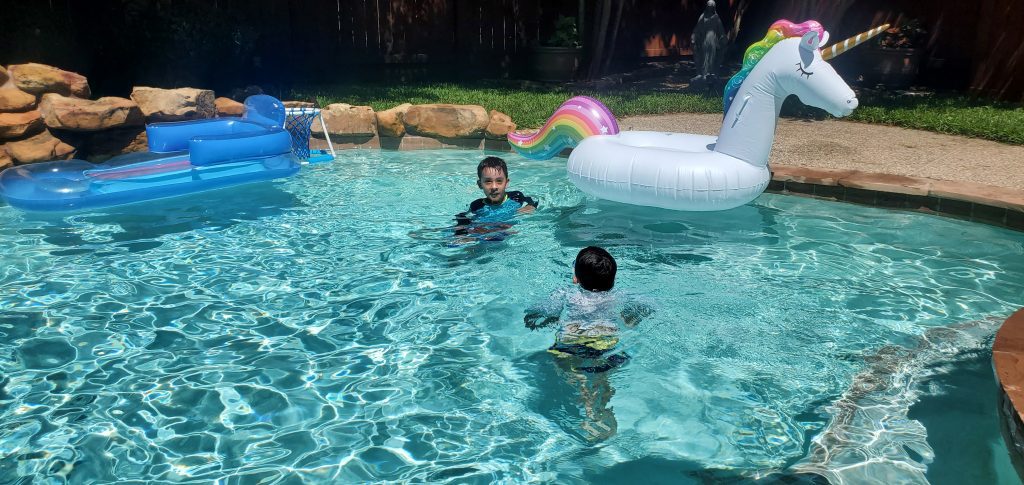Pandemic or not, there are few bigger items on our list of “mom worries” than drowning. And with good reason – it’s the leading cause of accidental deaths in kids ages 1 to 4. But there are some really simple ways to keep your kids safer. We spoke to Adam Katchmarchi, Ph.D., Executive Director of the National Drowning Prevention Alliance, to learn more. Here are the 5 things to know about this important topic:
For Younger Kids, Be Extra Careful with Backyard Pools
Amongst kids in that crucial 1 to 4 year old group, Adam says backyard swimming pools are the biggest risk. “One thing to stress, though, is that previous research has shown 70 percent of toddler drowning are happening during non-swim times,” says Adam. He says: “That’s where we need to use our strategy of multiple layers of protection.” For instance, the American Academy of Pediatrics recommends swim lessons starting as early as one year and definitely by age 4. “Pick lessons that are with your parenting strategy,” says Adam. For instance, survival-type swim schools that promise to teach your child to swim quickly are popular, but may not be the gentle approach you’re looking for. Or, they could be the right answer if you want your child to be safer, faster. The other big layer of protection? Physical barriers. “You want as many possible barriers to prevent them from reaching the water or various alarms that are on the market to alert you to a child entering the water,” says Adam.
You May Need to Talk to Your Neighbors
Whether you’re at a friend’s house, grandma’s condo or another private pool, you’ll want to be sure these protections are in place (or you’re taking extra precautions). Your neighbor’s pool is another place to check, even if you’re not going over there (since kids can wander over alone). “It’s important to have that conversation with your neighbors even if it can be uncomfortable,” says Adam. He suggests explaining the statistics and how a pool fence can protect all the kids in the neighborhood, noting that skier Bode Miller’s daughter drowned at a neighbor’s pool. “They had those precautions in place at their own home but they were in the living room at the neighbor’s home. Drowning is silent and quick – it can happen in as little as 20 to 60 seconds,” says Adam.
School Age Kids and Older Kids Have Different Risks
From ages 5 to 9, research shows kids are actually safer in the water, something Adam says may be attributable to adult supervision matched with better swim skills—underscoring the importance of lessons. “We do see a higher risk of drowning in the teenage years,” he notes. Interestingly, teen males are at higher risk and the risk is greater in open water. Alcohol and following peer behavior may be contributing factors.
Supervising Adults Should be Focused—and Trained
Adam says parents should designate a “water watcher”, and that person should not be drinking or otherwise distracted by a phone, book, etc. “We also encourage any childcare workers to have CPR and First Aid training. Having the knowledge of how to deal with an accident or emergency is crucial – it happens,” notes Adam.
If You’re Traveling, Call Ahead
“If you’re going to a hotel, condominium or Airbnb, contact them and talk about risk prevention and get a sense for what they have there,” says Adam. “Do they have a pool with or without a fence? Lifeguards? If not, maybe you want to choose a different property,” he explains. He also says to talk to your kids about the pool rules and precautions before you leave home—even toddlers can understand, even if they may not verbalize them back to you.
You Shouldn’t Rely 100% on Flotation Devices—Even Life Vests
Adam recommends against using the old school blow up arm “swimmies”. “give an absolute false sense of security; they are toys,” says Adam, who suggests using aa US Coast Guard approved flotation device instead. However, even then, this is only one layer of protection in addition to physical barriers from aa pool, excellent supervision, etc. Because even though they may help your child flight, they may not turn them face up in an emergency. Finally, be sure your child knows that they don’t know how to swim without them. “We’re concerned that children are having a false sense of security in the water. If 70 percent of drowning happens during no swimming times if they are usually wearing that puddle jumper in the pool, they may think they can swim without it. Take it off once in a while at least to make sure they know their true swimming ability,” says Adam.
Keep these rules in mind, and those layers of protection, in mind, and you and your family can enjoy a fun, and safer summer on and in the water. Says Adam: “No single layer is guaranteed to stop a drowning. We hope if one layer fails another steps into to stop a tragedy.”

